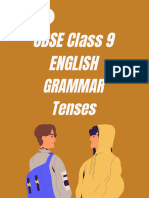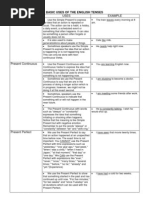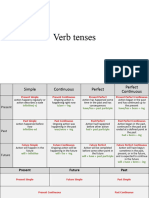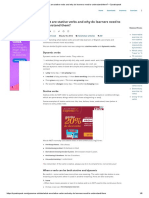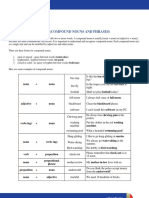Ch5tensespdf PDF
Ch5tensespdf PDF
Uploaded by
JesRomeroCopyright:
Available Formats
Ch5tensespdf PDF
Ch5tensespdf PDF
Uploaded by
JesRomeroOriginal Title
Copyright
Available Formats
Share this document
Did you find this document useful?
Is this content inappropriate?
Copyright:
Available Formats
Ch5tensespdf PDF
Ch5tensespdf PDF
Uploaded by
JesRomeroCopyright:
Available Formats
There are a number of state verbs in English;
we rarely use them in a continuous tense.
Existing or being be, consist of, contain, exist
belong to, have (=own), include, lack, own,
Possessing
possess. State verbs 'believe', 'have', 'like', etc.
adore, desire, despite, detest, dislike, envy,
Feeling or wanting hate, like, love, need, pity, prefer, trust,want,
wish.
They often describe states of being, thinking,
possessing or feeling.
believe, doubt, expect, feel (=think), forget,
imagine, intend, know, realize, recognize,
Thinking or believing
remember, see (=understand), suppose, think,
understand.
STATE VERBS
appearence appear, resemble, seem.
concern, cost, depend, deserve, fit, matter,
Other verbs
mean, measure, mind, weight.
It is possible to use many of the above verbs
in the continuous, but the verb either has a
different meaning or expresses a temporary
action. Using these verbs in the continuous
We use the present perfect continuous, often
with 'since' or 'for', to talk about an ongoing
situation or action which began in the past
and is still continuing, or has just finished.
We don't usually use the present perfect
continuous in the passive.
The present perfect simple often (but not
always) refers to a completed action, while
the continuous usually refers to an action that
Ongoing situations and actions.
is still ongoing.
When we use the continuous we focus on
duration, so we do not mention the number
of times that we have done an action.
If we give a number of times, we use the
present perfect simple,
The present perfect continuous can suggest
a temporary situation or action.
With 'lately' or 'recently', it often refers to new
developments which may be temporary.
We use the present perfect continuous + 'for',
not the present continuous, to specify the
Temporary situations.
duration of an activity which started in the
past and is still continuing.
PRESENT PERFECT CONTINUOUS.
Verbs like 'live', 'work', 'study', 'teach' can be
used in either the simple or continuous with
little difference except that the present
perfect simple is seen as more permanent.
We can use the present perfect continuous
to explain a present result. The focus is on
the activity rather than the result. In this case,
we don't usually use time adverbs. Present results.
Completions
Repeated action
Present perfect simple
Permanent situation
Focus on present result Present perfect simple and continuous:
Differences.
Continuation
Duration of action
Present perfect continuous
Temporary situation
Focus on the activity
We use the present perfect simple to talk
about situations that started in the past and
are still continuing in the present.
We often use the prepositions 'for' and 'since'
with this use..
When we use 'since' to introduce a new
Ongoing situations and actions.
clause, we usually use the past simple after it.
But note the use of either the present perfect
os past simple after 'it's (weeks/years/ages) The present continuous + 'for' expresses a
since...' to express a period of time when we present situation continuing into the future,
haven't done something. NOT a situation that began in the past.
We can use the present perfect for
completed actions in the past if they may
happen again, i. e. if the time period in which
the actions took place has not ended.
Sometimes we know the time is not 'finished'
because of the time expressions.
Unfinished time periods.
British English uses the present perfect after
superlatives, ordinal numbers, often followed
by 'ever'.
These adverbs are very common with the Already, always, ever, never, often, recently,
present perfect. seldom, so, far, still, to, now, yet.
Adverbs often used with the present perfect.
We use 'already' with the affirmative but 'yet'
with the negative and in questions. PRESENT PERFECT SIMPLE.
We can use the present perfect simple to talk
about an action completed in the past which
has a present result.
Present results.
Common adverbs with this use of the present
perfect are 'just', 'recently' and 'lately'.
As the present perfect simple expresses
relevance to the present, news reports often
start with this tense, before moving into past
tenses.
Similarly, we often use it to introduce a new
topic of conversation. Other uses.
In time clauses we can use the present
perfect with future reference.
We use a past or past perfect form, not the
present perfect, to correct an incorrect belief
or expectation, or to confirm a correct one. Present perfect and past simple: differences.
We use the past perfect simple to describe a
single action, or repeated actions, completed
before a time in the past.
We often include a specific time reference,
such as a clause with 'when' or 'by the time'.
We also use this form to describe a situation
which existed before a past event.
We use the past perfect continuous to
describe an ongoing situation or action which
continued up to, or stopped just before, a Actions and situations before a time in the
time in the past, often with 'before' or 'by the past.
time'.
We often use the continuous with 'for' or '
since' when we want to focus on the duration
of an action.
We don't usually use the past perfect
continuous for actions and backgrounds
situations still continuing at the same time as
the past simple narrative. We prefer to use
the past continuous.
The past perfect simple often refers to a
completed action, whereas the past perfect
continuous may refer to an action that was
still ongoing at the time of the statement.
We do not mention the number of times that Completed and ongoing actions.
we have done an action when we use the
past perfect continuous.
We often use the past perfect to describe the
reason for a past action or situation. Past reasons.
We can use the past perfect with the past
simple to make a sequence of events clear.
We use the past perfect for the earlier action
and the past simple for the later one.
PAST PERFECT SIMPLE AND
CONTINUOUS.
We can use 'just' with the past perfect to
show that the earlier action was very recent.
Or we can use 'already' to show that the
action happened sooner than we expected.
We don't usually use the past perfect if the
sequence is obvious and the first action
Sequence of past actions.
makes the second happen.
We can use either the past perfect or the
past simple with time conjunctions, e. g. '
after', 'before', 'as soon as', 'when'.
With 'before' + past perfect the action in the
past simple happens first.
We use them with main verbs to form tenses,
We can use this pattern for a past action questions and negatives.
which prevented a later action from Be, Have, and Do
happening. Auxiliary verbs We don't use them with modal verbs.
We can use the past perfect with
superlatives, ordinals (the first, second, last,
etc.), the only, etc. + ever.
Is the same as the infinitive, except after he,
We use the past perfect with verbs such as ' Present simple she or it. We form the negative and questions of the
hope', 'expect', 'want', 'plan', 'think about', ' present and past simple with the auxiliary
wish' to describe past intentions which were Other uses Forming Present and Past simple We add -ed to the infinitive. The form is the do.
unfulfilled. tenses Past simple same for all persons except with be.
Remember that we don't usually use the
continuous form with state verbs. Ch. 5: TENSES
Present continuous am/is/are + -ing form of main verb.
We use this for completed actions in the past. Past continuous was/were + -ing form of main verb.
If the context is clear, it is not necessary to
give a past time reference. Present Perfect Simple Has/have + past participle have walked
- Actions happening at the same time. Present perfect continuous Has/have been + -ing form of the main verb.
Repeated actions Completed actions and situations (past Past perfect Had + past participle.
simple). Forming other tenses
We use the past simple for Sequences of actions Past perfect continuous Had been + -ing form of main verb.
One action resulting in another Be careful not to omit have with the present
perfect.
States in the past
Use to is followed by an infinitive. Notice the
The past continuous describes an action in possible spellings in questions and negatives.
progress at a point of time in the past; the
action began before this point of time and
continued after it.
Temporary
We often use the past continuous to show Changing or developing
that a past action was
Providing a background to completed past
actions
We can use the Past Continuous for two
actions in progress at the same time. Past actions and situations in progress (past
continuous).
We usually use the Past simple for repeated
actions in the past, but we can use the past
continuous if we want to emphasize that the
repeated action took place over a temporary
period.
As with the present continuous, we can use
the past continuous (with 'always' and other
adverbs) to talk about repeated actions that
happened very often, or to express
annoyance.
We use the past continuous to contrast an
PAST SIMPLE AND CONTINUOUS; '
ongoing action with a single (past simple)
event which interrupts it. USED TO' AND 'WOULD'
We can put either clause first, and we can
use 'when', 'while' or 'as' to introduce the
Interrupted actions.
interrupted action.
We use 'when' (not while) to introduce the
interrupting (past simple) action.
We can use the past continuous to describe
past arrangements that may or may not have
taken place.
We often use verbs such as 'plan', 'expect', '
hope' for unfulfilled arrangements.
Other uses of the past continuous.
We can make requests, suggestions and
questions more tentative and polite by using
the past continuous. We often use the verbs '
think' and 'wonder'.
Both 'used to' and 'would' describe actions
which happened regularly in the past but no
longer happen or now happen with more or
less frequency.
To avoid confusion with other uses of 'would',
we usually mention the past time or situation.
We often continue with 'would' after a past
narrative has started with 'used to'.
We use 'used to', but NOT 'would' to describe
Used to and would.
past states which have changed.
Periods of time
We use the past simple, NOT 'used to', for
A number of times
Don't confuse 'used to' + infinitive with 'be/
get used to' which means 'be/become
accustomed to'.
Permanent situations, facts, things which are
generally true, opinions. We often use the present simple to describe
The present continuous describes a
temporary situation or action in progress at or
around the time of speaking. The action is
likely to continue after the time of speaking.
Common adverbs with this form are 'now', '
just', 'still', 'at the moment' and 'currently'.
Permanent and temporary situations
We use 'live', 'work' and 'stay' in the
continuous if the action is temporary.
We can use the present simple to draw
attention to someone arriving or leaving with '
here comes' and 'there goes'. These are
always present simple and appear before the
subject.
We use the present simple to describe things
that happen on a regular basis.
We often use the present simple with
adverbs of frequency (always, sometimes)
and expressions of frequency (every day,
once a week).
It is possible to use the present continuous to
talk about repeated events or actions, usually
if they happen within a temporary period.
We can use the present continuous for a Regular or repeated actions
series of actions that are more frequent than
we would normally expect.
We can use the present continuous with an
adverb such as 'always' 'forever' or '
continually' for frequently repeated actions.
This use is more emphatic than using the
present simple for repeated actions, and, with
a stressed adverb, expresses annoyance with Present simple or continuous?
the person who is doing the action.
We use the present simple to give directions
or instructions, often with impersonal 'you'.
This is similar to the imperative, but the
imperative can sound more abrupt.
Series of events/actions.
We use the present simple to express the
immediacy of an event, e. g. in sports
commentaries, particularly when the action is
over before the description finishes.
We use the present continuous to describe
pictures.
We can use the present continuous with the
present simple to give more immediacy to an
anecdote. We use the continuous for actions
which form a background and the simple for
Describing pictures, plots and telling
the actions that make up the narrative.
anecdotes.
This is often the way that we describe the
beginning of books, films or plays.
Newspaper headlines often use the present
simple to express a past event, which again
gives more immediacy to the event.
We use the present continuous to describe
things which are in the process of changing. Other uses
We use 'have' and 'be' to make perfect,
continuous and passive form of tenses.
We use 'do' (does/did) to form questions and
negatives in the present and past simple.
Uses of auxiliary verbs
It is possible to omit the auxiliary, and
sometimes the subject, in very informal
English and in headlines.
We usually use contracted auxiliaries in
speech and informal writing, either with the
subject or with 'not'.
'Has' and 'is' have the same contracted form '
s. Similarly, 'had' and 'would' are both
contracted 'd.
In spoken English (and when representing Use of contractions with auxiliaries
speech in writing), we can combine
contracted 'not' and contracted auxiliaries, e.
He shouldn't've done it. g. 've with modal verbs
We don't contract 'was'.
Exceptions and special cases
In formal English we don't use contractions
when there is more than one subject.
BE: exist, located in, behave.
DO: perform an action or complete a task. They can function as main verbs as well as
auxiliaries.
HAVE: to talk about possession, inclusion,
relationships, experiences, illnesses/ AUXILIARIES AND 'HAVE GOT'
disabilities and dreams, actions.
Sometimes we use 'have + noun' when there
is no single appropriate verb in English.
Be, have and do as main verbs
In British English we can use 'have' without
auxiliary 'do' in questions and negatives.
We DON'T usually use the passive of main
verb 'have'. When we do, it has the meaning '
be tricked or cheated'.
We use 'have got' as an alternative to 'have'
for possession and other states in the
present. It is generally preferred to 'have' in
informal British English, especially in the
negative.
We usually use a form of 'have', not 'have
got', to talk about past or future possession.
'Have got' and 'have' do not have continuous
or passive forms when they mean 'posses'.
We also use 'have/has/had got' as the
present/past perfect form of the verb 'get'.
Have got
We can use 'have got' as a perfect infinitive (
past form of the infinitive) with these
Obtain and receive meanings.
To describe actions
In short answers
In questions tags We don't use 'have got' in these ways
With 'used to'
As a perfect infinitive expressing 'posses'
You might also like
- French Verb Tense Timeline21Document44 pagesFrench Verb Tense Timeline21Alexandar Apisha100% (1)
- Duolingo French Tips & NotesDocument114 pagesDuolingo French Tips & Notes林意朗No ratings yet
- Present Perfect Continuous Tense - by Diffit (Printable)Document5 pagesPresent Perfect Continuous Tense - by Diffit (Printable)juliejuice3No ratings yet
- Grammar Tenses: PresentDocument3 pagesGrammar Tenses: PresentPaola FloresNo ratings yet
- Focus-BrE5 StudentsBook Unit1-GrammarFocus PDFDocument3 pagesFocus-BrE5 StudentsBook Unit1-GrammarFocus PDFJulio Emmanuel MezaNo ratings yet
- Usage of Different TensesDocument2 pagesUsage of Different TensesBernadetteLimNo ratings yet
- Blue Doodle Project PresentationDocument8 pagesBlue Doodle Project PresentationHediana KurniatiNo ratings yet
- Formula Grammar PPT B2 U1Document9 pagesFormula Grammar PPT B2 U1marzenaNo ratings yet
- Present Continuous Jonathan BastidasDocument7 pagesPresent Continuous Jonathan BastidasjabastidasmNo ratings yet
- Gramatica para InglesDocument12 pagesGramatica para InglesAlex Eduard Campos LealNo ratings yet
- Ingles PAST CONTINUOUSDocument4 pagesIngles PAST CONTINUOUSDavid Robles HerreraNo ratings yet
- Uts PPT B.inggris, MonicDocument11 pagesUts PPT B.inggris, Monicsariwana635No ratings yet
- Continuous Verb TensesDocument67 pagesContinuous Verb TensesEjhay RodriguezNo ratings yet
- Devi Puji - Present Perfect TenseDocument21 pagesDevi Puji - Present Perfect TenseDeviNo ratings yet
- Resumen InglesDocument9 pagesResumen InglesValentina OntiverosNo ratings yet
- Documento 11Document1 pageDocumento 11Alejandra QuecanoNo ratings yet
- SimpleDocument1 pageSimpleAzim DurdyevNo ratings yet
- Presentation 3Document8 pagesPresentation 3Alexis JosueNo ratings yet
- B2 - U1 Present TensesDocument14 pagesB2 - U1 Present TensesDAYANA MELISA CAMONES VERA100% (1)
- Present and Past TensesDocument3 pagesPresent and Past TensesAia NikolovaNo ratings yet
- Present Tenses - Simple - Continuous - PerfectDocument10 pagesPresent Tenses - Simple - Continuous - PerfectBalby PeñaNo ratings yet
- Organizador Gráfico Mapa Conceptual Hand-Drawn Negro y VerdeDocument1 pageOrganizador Gráfico Mapa Conceptual Hand-Drawn Negro y Verdeoscarin.martin.oampNo ratings yet
- Continuous Verb TensesDocument118 pagesContinuous Verb Tensesstits81No ratings yet
- Eng Verb Tenses PDFDocument8 pagesEng Verb Tenses PDFEnilda ReyesNo ratings yet
- Present Perfect and ContinuousDocument1 pagePresent Perfect and Continuouslesya.pavliv71No ratings yet
- Perfect Tenses Cheat Sheet: by ViaDocument2 pagesPerfect Tenses Cheat Sheet: by ViaAura SkyNo ratings yet
- ilovepdf_mergedDocument22 pagesilovepdf_mergedtarakautimliltNo ratings yet
- EP Grammar Ref CastilianDocument8 pagesEP Grammar Ref CastiliancamtotalproNo ratings yet
- Advanced French Verb ChartDocument3 pagesAdvanced French Verb ChartHammad Aqeel100% (1)
- Class 6 To 10 English Tense WorksheetDocument68 pagesClass 6 To 10 English Tense WorksheetSubhasri HhssNo ratings yet
- TenseDocument10 pagesTense2357011035No ratings yet
- TenseDocument2 pagesTenseRBT10621 Noorain Maisarah Binti ZainalNo ratings yet
- 02 Summary of Tenses & Aspects of VerbsDocument10 pages02 Summary of Tenses & Aspects of Verbslasnfbf asigfnNo ratings yet
- Verbs & Tenses - Class MaterialDocument7 pagesVerbs & Tenses - Class MaterialJuhika BhattNo ratings yet
- Tugas Pertama Bhs Inggris (Tenses)Document1 pageTugas Pertama Bhs Inggris (Tenses)Isnaniyaul KhasanahNo ratings yet
- Present TenseDocument18 pagesPresent Tensefarhancaniago962No ratings yet
- Starter Unit: 0.1 Present Simple 0.3 Stative VerbsDocument11 pagesStarter Unit: 0.1 Present Simple 0.3 Stative VerbsAlberto SanchezNo ratings yet
- MEG 3 SummaryDocument13 pagesMEG 3 Summarytonettesmile2695No ratings yet
- Eng GrammarDocument9 pagesEng GrammarSeba Tube HDNo ratings yet
- Present Continuous Tense - ENGLISH PAGEDocument2 pagesPresent Continuous Tense - ENGLISH PAGEMelanie CampoverdeNo ratings yet
- Use The Different Present Tenses If We: It's Easier To Understand When We Compare ThemDocument9 pagesUse The Different Present Tenses If We: It's Easier To Understand When We Compare ThemAyelén HawryNo ratings yet
- 5th Semester Block 1 Perfect Continuous TensesDocument21 pages5th Semester Block 1 Perfect Continuous TensesLeonardo Salgado LopezNo ratings yet
- Gramàtica Essencial: Temps VerbalsDocument7 pagesGramàtica Essencial: Temps VerbalsMar PerezNo ratings yet
- Explanations of TensesDocument10 pagesExplanations of TensesNalin Hettiarachchi100% (1)
- Grammar B2 - 1 Present TensesDocument10 pagesGrammar B2 - 1 Present TensesHanna ZiebaNo ratings yet
- Explore The World of English TensesDocument13 pagesExplore The World of English Tensescaroline.helmiNo ratings yet
- You Walk For Two Hundred: Verb TenseDocument2 pagesYou Walk For Two Hundred: Verb TenseMinervaHernandezSalazarNo ratings yet
- Grammar Verb TenseDocument4 pagesGrammar Verb TenseSofia T.H.T:3No ratings yet
- Present Perfect TenseDocument12 pagesPresent Perfect TenseAdrian PazNo ratings yet
- TENSESDocument14 pagesTENSESms.guska.2004No ratings yet
- English Verb TensesDocument50 pagesEnglish Verb TensesGangadhar86% (7)
- Basic Uses of The English TensesDocument4 pagesBasic Uses of The English Tensesgunasekaranmba75% (4)
- Curso B1.1 - Lesson 2Document23 pagesCurso B1.1 - Lesson 2Camila DalceroNo ratings yet
- Cuadro Comparativo: Escuela UniversidadDocument4 pagesCuadro Comparativo: Escuela UniversidadRosmiri Osorio GomezNo ratings yet
- Tempos Verbales en InglésDocument2 pagesTempos Verbales en InglésLorys RuizNo ratings yet
- Unit 1 - Present TensesDocument10 pagesUnit 1 - Present Tenseswjcz01No ratings yet
- Verb TensesDocument20 pagesVerb Tensesvpetrovaa23No ratings yet
- What Are Stative Verbs and Why Do Learners Need To Understand Them - SpeakspeakDocument8 pagesWhat Are Stative Verbs and Why Do Learners Need To Understand Them - SpeakspeakclaualvarezfloripaNo ratings yet
- Present Perfect Simple and Continuous - IntermediateDocument4 pagesPresent Perfect Simple and Continuous - IntermediateALEJANDRA2605No ratings yet
- Charts for Intermediate Hebrew Grammar and Syntax: A Quick Reference Guide to Going Deeper with Biblical HebrewFrom EverandCharts for Intermediate Hebrew Grammar and Syntax: A Quick Reference Guide to Going Deeper with Biblical HebrewNo ratings yet
- GLEC Lesson-1 BLC PDFDocument51 pagesGLEC Lesson-1 BLC PDFgunpeeNo ratings yet
- Kumpulan Maeri Speaking Gen CommunicationDocument12 pagesKumpulan Maeri Speaking Gen Communicationlukman arifNo ratings yet
- Ejercicios Inglés 2º ESODocument12 pagesEjercicios Inglés 2º ESOLorena Fernández MorenoNo ratings yet
- Gerunds N InfinitivesDocument13 pagesGerunds N InfinitivesDeepika Seth50% (2)
- Anguage: Name - ClassDocument4 pagesAnguage: Name - ClassВалерия Грушина100% (1)
- Place Preposition (On, In, At)Document67 pagesPlace Preposition (On, In, At)Anonymous 8AHCMsPuNo ratings yet
- English DLL - Week 6Document5 pagesEnglish DLL - Week 6Angelica Pastrana Dela CruzNo ratings yet
- Libro OK para Los Estudiantes - CompressedDocument43 pagesLibro OK para Los Estudiantes - CompressedLuis Daniel Ramirez MartinezNo ratings yet
- Narrative Styl RulesfinalDocument15 pagesNarrative Styl RulesfinalChandanNo ratings yet
- Present Perfect Tense Kelas 9Document9 pagesPresent Perfect Tense Kelas 9Tsabita HasanahNo ratings yet
- TOEFL Practice Test 1999 PDF FreeDocument6 pagesTOEFL Practice Test 1999 PDF FreeO hx iyfNo ratings yet
- Intro LP - 2.4.2Document3 pagesIntro LP - 2.4.2JoaquinNo ratings yet
- Mg3-5a-How Speakers Represent The WorldDocument20 pagesMg3-5a-How Speakers Represent The Worldsyafni nadiaNo ratings yet
- DeixisDocument16 pagesDeixisEg-22 Zara ilyasNo ratings yet
- MSW A4 FormatDocument4 pagesMSW A4 Formatrathish14uNo ratings yet
- Unit 6 Compound NounsDocument6 pagesUnit 6 Compound NounsFrancisco Chaire Gonzalez0% (1)
- Sem 11Document20 pagesSem 11Dedy SubandowoNo ratings yet
- Reported SpeechDocument2 pagesReported SpeechEDUARD MUÑOZ CENIZONo ratings yet
- Kelas XI Explanation TextDocument8 pagesKelas XI Explanation TextLala YayaNo ratings yet
- ESPS SMA English XI Chapter 5Document7 pagesESPS SMA English XI Chapter 5Eunike carolineNo ratings yet
- TQs Q2 PT in English 8Document48 pagesTQs Q2 PT in English 8Mar Fred AroNo ratings yet
- 070 Spanish SubjunctiveDocument2 pages070 Spanish SubjunctiveHugh Fox IIINo ratings yet
- Assignment 1 Basic GrammarDocument4 pagesAssignment 1 Basic GrammarHayatin Puspa DilahNo ratings yet
- कारकप्रकरणम् पत्राधारःDocument12 pagesकारकप्रकरणम् पत्राधारःABHINANDU PSNo ratings yet
- Fragment and Run-On SentencesDocument17 pagesFragment and Run-On SentencesandieNo ratings yet
- Navi DictionaryDocument47 pagesNavi DictionaryOdetteNo ratings yet
- Robert Abiol-Grade 6 EnglishDocument58 pagesRobert Abiol-Grade 6 EnglishRobert KaneNo ratings yet
- Grammar and Vocabulary Unit 8 PRACTICE 1: Past Participles Present Perfect: QuestionsDocument1 pageGrammar and Vocabulary Unit 8 PRACTICE 1: Past Participles Present Perfect: QuestionsToñi Varo GarridoNo ratings yet
- Unit2Document22 pagesUnit2Sarah DewanNo ratings yet





























